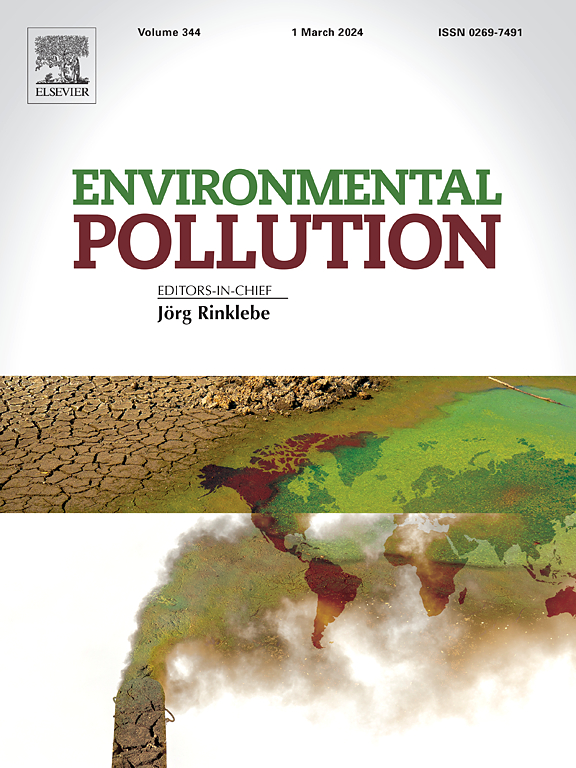Elucidating the enzymatic response of the white rot basidiomycete Abortiporus biennis for the downgrade of polystyrene
IF 7.6
2区 环境科学与生态学
Q1 ENVIRONMENTAL SCIENCES
引用次数: 0
Abstract
Plastic pollution is a growing global environmental concern, with polyolefins such as polyethylene and polypropylene, as well as polystyrene (PS) constituting a significant amount of plastic waste. Both polyolefins and PS, when inappropriately disposed of in the environment, contribute to environmental contamination since they degrade slowly, with both abiotic and biotic factors contributing to their downgrade. In terms of the microbial effect on plastics, in recent decades, several studies have focused on the biodeterioration and assimilation of polyolefins, while more comprehensive degradation of PS by diverse organisms, including bacteria, fungi, and even insect larvae, has been documented. The present study investigates the biocatalytic potential of the white-rot basidiomycete Abortiporus biennis LGAM 436 for PS degradation. Building on prior research, we examined the ability of this fungal strain to modify the structure of different PS forms, including commercial expanded polystyrene (EPS) foam and amorphous PS film. In addition, we explored the impact of olive oil mill wastewater (OOMW) effluent as an enzymatic inducer to enhance the degradation process. Through gel permeation chromatography (GPC), surface morphology changes, and FTIR-ATR analysis, we assessed the extent of PS degradation and identified relevant enzymatic activities via proteomics. The findings offer insights into the discovery of novel fungal biocatalysts for addressing plastic pollution, particularly through the action of high-redox oxidative enzymes.


塑料污染是一个日益严重的全球环境问题,聚乙烯和聚丙烯等聚烯烃以及聚苯乙烯(PS)构成了大量的塑料废物。聚烯烃和聚苯乙烯在环境中处置不当会造成环境污染,因为它们降解缓慢,非生物和生物因素都会导致其降解。就微生物对塑料的影响而言,近几十年来,一些研究主要集中在聚烯烃的生物降解和同化方面,而由细菌、真菌甚至昆虫幼虫等多种生物对聚苯乙烯进行更全面降解的研究也有记载。本研究调查了白腐基枝菌 Abortiporus biennis LGAM 436 降解 PS 的生物催化潜力。在先前研究的基础上,我们研究了这种真菌菌株改变不同形式 PS 结构的能力,包括商用发泡聚苯乙烯(EPS)泡沫和无定形 PS 薄膜。此外,我们还探索了橄榄油厂废水(OOMW)作为酶诱导剂对增强降解过程的影响。通过凝胶渗透色谱法(GPC)、表面形态变化和傅立叶变换红外-ATR 分析,我们评估了 PS 降解的程度,并通过蛋白质组学确定了相关的酶活性。这些发现为发现新型真菌生物催化剂,特别是通过高氧化还原氧化酶的作用来解决塑料污染问题提供了启示。
本文章由计算机程序翻译,如有差异,请以英文原文为准。
求助全文
约1分钟内获得全文
求助全文
来源期刊

Environmental Pollution
环境科学-环境科学
CiteScore
16.00
自引率
6.70%
发文量
2082
审稿时长
2.9 months
期刊介绍:
Environmental Pollution is an international peer-reviewed journal that publishes high-quality research papers and review articles covering all aspects of environmental pollution and its impacts on ecosystems and human health.
Subject areas include, but are not limited to:
• Sources and occurrences of pollutants that are clearly defined and measured in environmental compartments, food and food-related items, and human bodies;
• Interlinks between contaminant exposure and biological, ecological, and human health effects, including those of climate change;
• Contaminants of emerging concerns (including but not limited to antibiotic resistant microorganisms or genes, microplastics/nanoplastics, electronic wastes, light, and noise) and/or their biological, ecological, or human health effects;
• Laboratory and field studies on the remediation/mitigation of environmental pollution via new techniques and with clear links to biological, ecological, or human health effects;
• Modeling of pollution processes, patterns, or trends that is of clear environmental and/or human health interest;
• New techniques that measure and examine environmental occurrences, transport, behavior, and effects of pollutants within the environment or the laboratory, provided that they can be clearly used to address problems within regional or global environmental compartments.
 求助内容:
求助内容: 应助结果提醒方式:
应助结果提醒方式:


